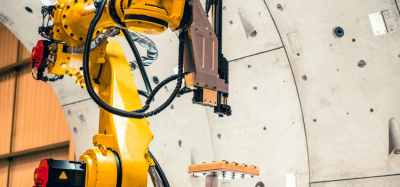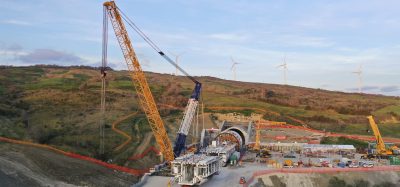Gotthard and Ceneri base tunnels on target
Posted: 1 August 2013 | | No comments yet
Work on the Gotthard and Ceneri base tunnels is on course. In the Gotthard Base Tunnel between Erstfeld and Sedrun, the ballastless railway track has been laid in both tubes. In total, 45% of the railway infrastructure systems have been installed. A pilot operation between Faido and the south portal at Bodio will start on schedule in December 2013 – a further important milestone on the way to the world’s longest railway tunnel becoming operational in 2016. Also, more than 60% of the Ceneri Base Tunnel has now been excavated. AlpTransit Gotthard Ltd is confident that the Ceneri Base Tunnel will be ready for operation with scheduled train services in 2019.
Gotthard Base Tunnel: status
Overground section Altdorf–Rynächt
The environment between Altdorf and Erstfeld has changed during the last year. Work on the built structures along the overground section is complete. In August 2012, the Riedstrasse underpass was completed, and in September 2012 the Wysshus underpass and both roundabouts were completed.
Since 3 December 2012, SBB has had two tracks available between Altdorf and Erstfeld. Because of the construction work on the approach route to the Gotthard Base Tunnel, for a period of one year the entire north-south traffic south of Altdorf railway station had to travel on a single track. AlpTransit Gotthard Ltd had 12 months in which to complete the complex construction work on the SBB main line. New bridges, underpasses and retaining walls were built, after which SBB equipped the new railway line with tracks, points, overhead conductors and cable systems.
In December 2012, the Stägwald retaining wall attained its final height. Further concreting work was executed and the dimensions of the complete built structure are becoming increasingly impressive.
Erstfeld
In the last 12 months, the appearance of the landscape at Erstfeld has changed. On the installations site, the conveyor-belt systems, train-loading bay and loading ramp have been dismantled and removed.
From February 2012 until September 2012 in the east tube, the ballastless track was laid between Erstfeld and Sedrun. This work was performed using a mobile concrete-making plant on rails – at approximately 500m-long, the concrete train was developed specially for the Gotthard Base Tunnel project. Approximately 220m of track were concreted per day. In March 2012 following completion of the structural works, installation of the railway infrastructure systems also began in the west tube.
At the end of March 2013, the permanent rails had been laid in both tubes from Erstfeld to Sedrun (around 22km). Following the laying of ballastless track, the overhead conductors are being installed in the tunnels.
Amsteg
Dismantling and removal work has been performed at the installations site at Amsteg.
The gravel plant was dismantled and the Erstfeld–Amsteg construction-site track and the visitor trail were removed. Part of the gravel deposit area has already been re-cultivated and sown and the dry-stone walls and hiking trail are now being constructed.
Sedrun
In June 2012 at Sedrun, the attractive Lag Claus Surrein bathing lake was inaugurated. The lake is located on a deposit of material excavated from the Gotthard Base Tunnel. As part of the renaturing measures, a 3,200m2 lake was created on the deposit. Along with a kiosk, terrace and sanitary facilities, the lake has become a popular summer attraction.
In 2012, the north and south track-crossover doors were installed in the multifunction station. The doors were transported by road from Erstfeld to Sedrun and assembled on site. During normal operation the doors are closed and aero dynamic ally separate the tubes. When needed, for example during main – tenance work, they can be opened to allow trains to pass.
In parallel with the installation of the railway systems, final fitting-out work was completed in the multifunction station at Sedrun. In Shaft 1, the shaft lift and machinery were dismantled and removed. During operation, Shaft 1 serves as a fresh-air duct as well as containing various cables for the railway systems and water pipelines for the multifunction station. At the end of December 2012, the final section of the multifunction station was handed over by the construction contractor to AlpTransit Gotthard Ltd. On 1 March 2013, the entire area of the multifunction station at tunnel level was handed over to the railway systems contractor.
In March 2013, dismantling work began in Shaft 2.
Faido
From mid-2012 to mid-2013, the multifunction stations, ventilation centres and railway systems buildings at Faido and Sedrun were mech – anically and electromechanically fitted out.
In January 2012, preparatory work for the future portal building at Faido began. At the end of 2012, the external walls of the base – ment of the building had already been concreted. In December 2012 in the lateral cavern – the twostorey railway systems building – was completed.
Installation of the bench and cable tray proceeded rapidly. Also in December 2012, finishing work in both single-track tubes between the multifunction station at Faido and the section boundary at Sedrun was largely complete. Since January 2013, the installation of doors and ventilation systems in all 41 crosspassages is complete.
In January 2013, the 22km of tunnel were handed over by the tunnel construction contractors to AlpTransit Gotthard Ltd. Since March 2013, the railway systems are also being installed at Faido.
Bodio
The east tube at Bodio is still being used to transport supplies to the construction sites in the Bodio section. In November 2012, an additional supply line for intermodal transport was set up. At Bodio, road trucks can drive over special ramps onto railway wagons. They are then transported on the finished tracks in the west single-track tube to the multifunction station at Faido. Work on concreting the bench to the south continues. At the end of April 2013, around 13,930m of bench had been concreted on both sides.
In the west tube, the cable ducts and electrical enclosures in the cross-passages were installed as well as the evacuation-route signs and emergency lighting. In the west tube between Faido and the south portal at Bodio, preparations are in progress for pilot operation. From December 2013 on this approximate 16kmlong section in which the railway infrastructure systems have already been installed, test runs at speeds of up to 230km/h will take place.
Biasca
At Nodo della Giustizia junction, work on important built structures continues. These include the bridge over the Froda Canal, the cutand- cover Giustizia Tunnel, and the retention basin of the Stabiello stream with underground outflow into the Froda Canal. Ballast has been laid for the embankment of the new route of the cantonal road.
In February 2013, work began on the final landscaping of the south portal. Construction of the retention wall along the Pollegio substation is complete and planting work for final landscaping of the Buzza di Biasca continues.
Ceneri Base Tunnel: status
At the end of April 2013 in the Ceneri Base Tunnel, almost 62% of the 39.9km-long tunnel had been excavated and excavation and concreting work continues in both tubes.
Camorino
Around Camorino, to the north of the north portal of the Ceneri Base Tunnel, work has continued on various built structures and subprojects. These include the erection of the first V-pillars for the approximate 1km-long Lugano– Bellinzona viaduct. In autumn 2012, the old railway bridge over the A2 motorway near the Bellinzona exit was demolished. It will be replaced by two new bridges situated adjacent to each other. During the night of 10 March 2013, the first of the two new railway bridges over the A2 motorway was successfully moved hori – zontally by 14m. In May 2013, construction of the second bridge began. From 2019, railway traffic will travel over the four tracks of the new bridges: two tracks will be available for the existing Giubiasco–Cadenazzo line and two further tracks will continue in the direction of the north portal of the Ceneri Base Tunnel. In December 2012, most of the work south of the cantonal road was complete. This marks successful completion of the first main lot, on which construction began in 2008.
Vigana
Near the north portal at Vigana, the invert of the connecting tunnel between the east and west caverns and in the east tube has been con – creted. In the east tube and the bretella, work on the seal and inner-lining is complete. In March 2013, work began on the inner-lining of the west tube.
Sigirino
All driving work in the Ceneri Base Tunnel from Sigirino has continued. The Linea Val Colla South geological fault zone was overcome without major problems. At the same time, the invert was laid.
The spoil deposit at Sigirino continues to grow and the Dosso di Taverne wild-animal corridor is structurally complete.
Around 62% of the Ceneri Base Tunnel, as at the end of May 2013 has been excavated. In the main drive towards the south, the lead on the contractually agreed time schedule increased to approximately five months. The northward drives are lagging 10 to 11 months behind the construction schedule, mainly because of geological difficulties. AlpTransit Gotthard Ltd is nevertheless confident that the Ceneri Base Tunnel will be ready to operate scheduled train services at the end of 2019 as planned.
Vezia
Underground lining work in the west and east tubes was completed in November 2012.
Work on the cut-and-cover tunnel began in December 2012 and the first invert and vault blocks have now been concreted.
In the area of the new railway embankment, work on the railway systems, substructures and infrastructure has begun with execution of the cable blocks, foundations for the overhead conductor masts and concrete slabs.
Outlook
From December 2013 in the Gotthard Base Tunnel, test runs at speeds of up to 230km/h will take place. The 16km-long section between Bodio and Faido is already completely equipped with the railway infrastructure systems.
In the Ceneri Base Tunnel, also in the coming year, excavation work will only take place from the intermediate heading at Sigirino. Driving is scheduled to be completed in 2016, after which the railway systems will be installed. Invitations for tender were issued in 2012 and contracts will be awarded during the current year.
From today’s standpoint, opening of the Gotthard Base Tunnel for operations in 2016 and the Ceneri Base Tunnel in 2019 is feasible.
Biography
Renzo Simoni joined AlpTransit Gotthard Ltd on 1 April 2007. His previous employment included periods with Helbling Beratung + Bauplanung AG, Ernst Basler + Partner AG and Gruner AG. Renzo studied civil engineering at the Swiss Federal Institute of Technology (ETH), Zurich, followed by a postgraduate diploma and doctorate at the ETH Institute of Spatial Planning.







